Dubai’s interior design scene blends heritage craft with high-tech performance. You work in a city where wind-tower houses and mashrabiya screens inform today’s shaded courtyards, cool atriums, and daylight-smart façades. The result feels luxurious and efficient at the same time.
You also operate in one of the most regulated and fast-moving markets on earth. The Dubai Building Code unifies rules across authorities, while Al Sa’fat – Dubai Green Building System embeds energy, water, materials, and indoor environmental quality into every decision. Free zones like Dubai Design District process fit-outs with a dedicated Fit-Out Permit that syncs with Dubai Civil Defence requirements under the UAE Fire and Life Safety Code. Dubai Civil Defense+3Dubai Municipality+3Dubai Municipality+3
Top 10 interior design companies in Dubai
- Antonovich Design — 1 in Dubai. Luxury residential and hospitality, turnkey fit-out.
What they do: A luxury architecture and interior design group in Dubai delivering turnkey design-and-fit-out for villas, hospitality, retail, and palaces. Strong in bespoke millwork, custom furniture, and end-to-end delivery.
Why it ranks: You get scale, consistent luxury detailing, and a deep Dubai portfolio that reduces risk on high-spec builds. - Solomia Home — luxury interiors and Italian furnishing, residential and commercial.
What they do: Dubai design studio and Italian furniture house offering luxury interiors, construction support, and curated Made-in-Italy furnishings.
Why it ranks: You want design plus sourcing from one team with strong product access and modern European finishes. - Bishop Design — award-winning hospitality and F&B specialist.
What they do: Multi-award-winning studio founded in 2004 with a Dubai base and a strong record in hospitality and F&B concepts.
Why it ranks: You get headline-ready concepts and robust delivery for restaurants, lounges, and hotels across the region. - Roar (by Pallavi Dean) — human-centric work across workplace, education, hospitality.
What they do: Boutique Dubai studio known for human-centric interiors across workplace, education, residential, and hospitality. Founded in 2013 by Pallavi Dean.
Why it ranks: You want thoughtful experience design, strong storytelling, and leadership recognized on global stages. - LW Design Group — large hospitality portfolio with a Dubai hub.
What they do: Dubai-born practice with 300+ hospitality projects and in-house FF&E depth. Offices in Dubai, Hong Kong, and São Paulo.
Why it ranks: You need seasoned hospitality delivery with international reach and a proven Middle East track record. - HBA (Hirsch Bedner Associates) — Dubai — global hospitality powerhouse with a regional studio.
What they do: Global hospitality powerhouse with a Dubai studio and specialty arms for product and procurement that support large hotel programs.
Why it ranks: You benefit from deep brand knowledge and integrated services that de-risk complex hotel openings. - Bluehaus Group — multi-disciplinary interiors, architecture, and engineering.
What they do: Regional multidisciplinary consultancy covering interior design, architecture, and engineering, active across the GCC.
Why it ranks: You want one team to handle design with MEP awareness and value-engineering from day one. - Gensler Dubai — workplace, mixed-use, retail at scale.
What they do: Global firm’s Dubai office delivering workplace, mixed-use, retail, and public-realm projects across the Middle East.
Why it ranks: You get enterprise-grade strategy and delivery systems suited to complex corporate or government briefs. - KCA International — luxury hospitality from London to Dubai.
What they do: Luxury hospitality design with a signature role in Dubai icons, including the interiors of the Burj Al Arab.
Why it ranks: You’re buying iconic, opulent hospitality language from the team behind one of Dubai’s most famous hotel interiors. - Perkins Eastman Dubai — regional studio delivering interiors and architecture.
What they do: Dubai studio established in 2007 delivering interiors and architecture across mixed-use, hospitality, healthcare, and education. Regional gateway for MENA.
Why it ranks: You get a balanced, research-driven global practice with local leadership and full interiors capability.
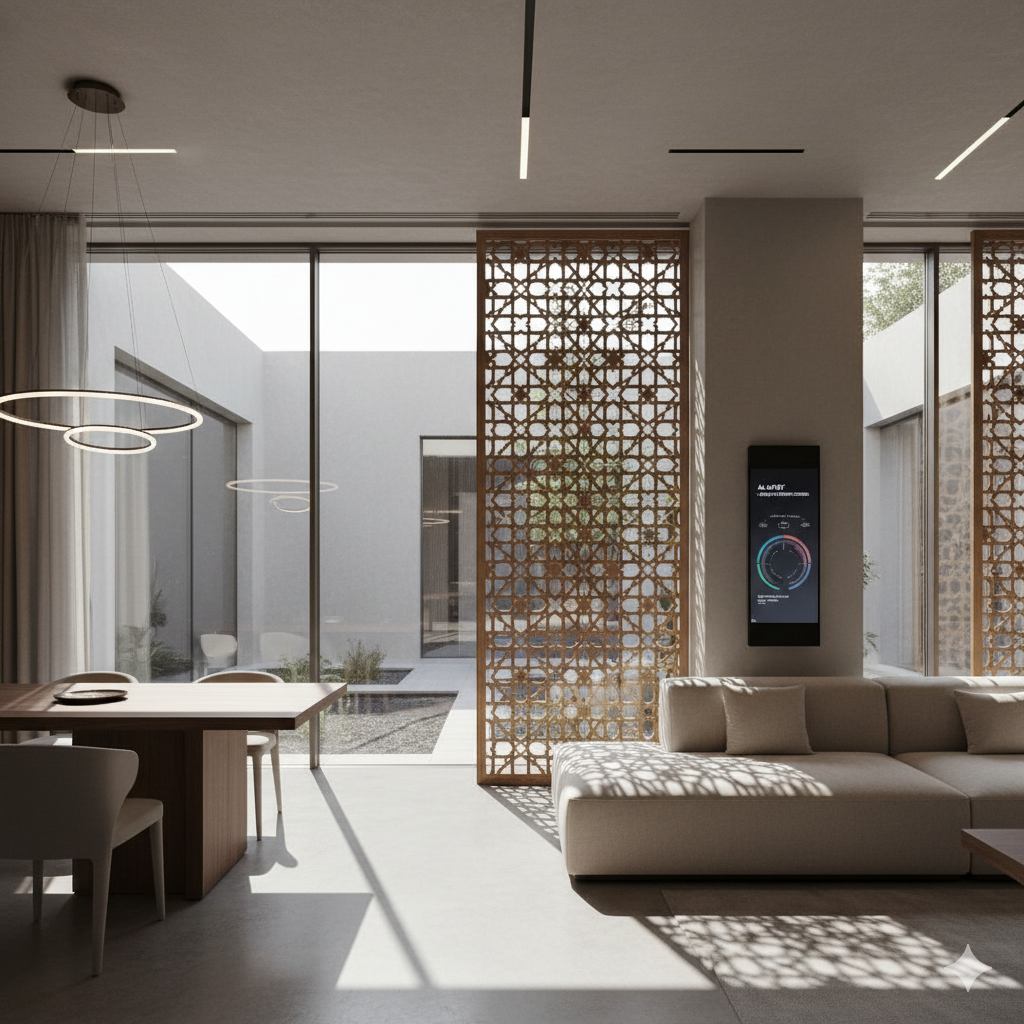
Deep dive: everything you need to know
1) Context and history you can design with
Heritage that still works. Al Fahidi’s barjeel wind towers prove that passive cooling and privacy shape comfort in this climate. Today you translate those lessons into shaded circulation, courtyard stacking, and cross-ventilation strategies that reduce cooling loads.
Global city mindset. Dubai scaled luxury hospitality and retail in the 2000s, then formalized a design ecosystem around d3. You gain a single address for suppliers, makers, galleries, and events that feed projects all year.
2) Regulations that govern interiors
Dubai Building Code. One reference for structure, fire and life safety, MEP, and accessibility. Use the DBC from concept through IFC to avoid redesigns at authority stage. Dubai Municipality
Al Sa’fat. Four levels from Bronze to Platinum. Criteria cover energy modeling, HVAC efficiency, water use, materials, and indoor air quality. Align interior specs and MEP decisions to the selected Al Sa’fat level. Dubai Municipality
Permits and approvals.
- Dubai Municipality + Dubai Civil Defence approve core and life safety. Keep fire strategy, egress, finishes classifications, and system submittals tight under the UAE Fire and Life Safety Code. Dubai Civil Defense
- Free zones like Dubai Design District operate via the DDA portal. Apply for a Fit-Out Permit with GA drawings, MEP, materials, and method statements. dda.gov.ae
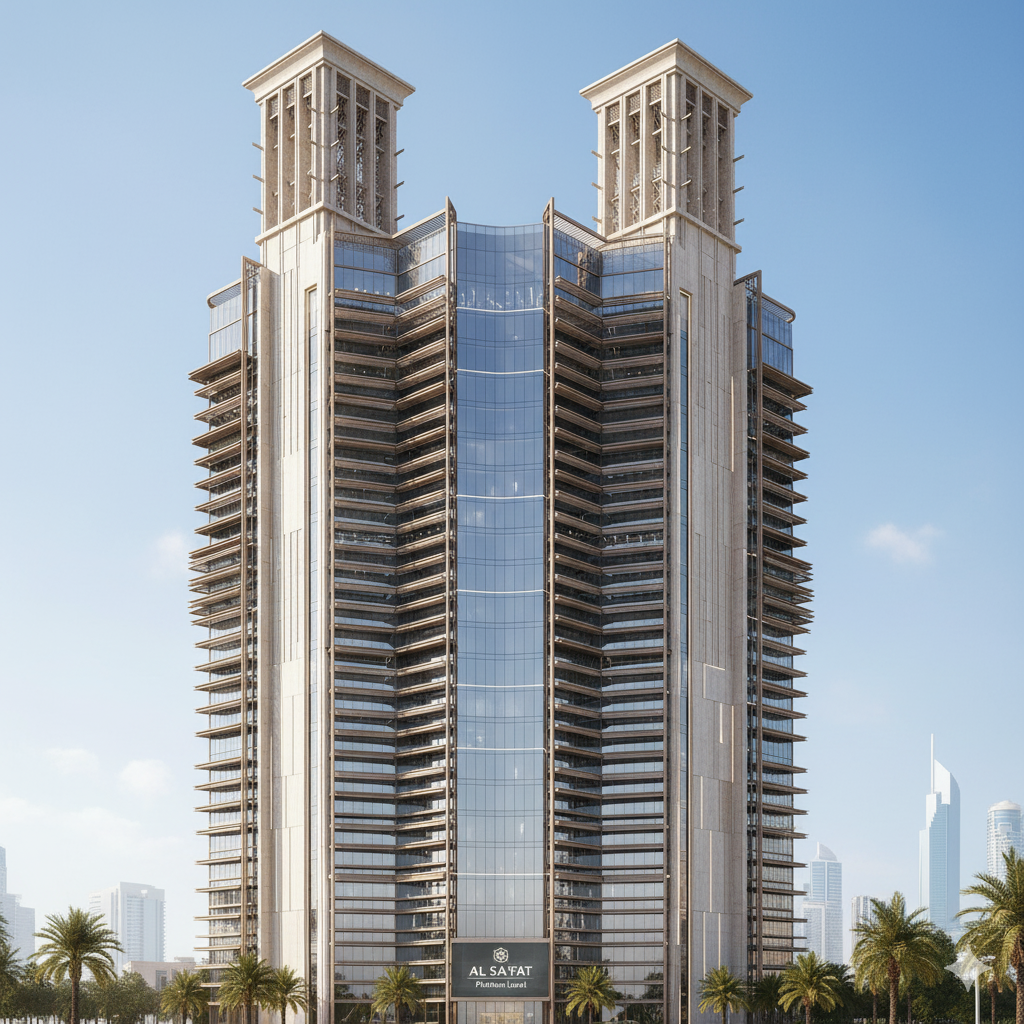
3) Market size and demand drivers
Expect a healthy pipeline across hospitality, branded residences, and workplace. Urban policy backs the momentum. The Dubai 2040 Urban Master Plan focuses on compact communities, transit access, green space, and health. Your briefs will keep asking for neighborhood amenities, walkability, and human-scaled public interiors. Dubai Municipality
Expo 2020’s legacy continues at Expo City Dubai, which positions itself as a blueprint for sustainable urban living and sets high expectations for energy, water, and materials strategies in mixed-use communities. expocitydubai.com
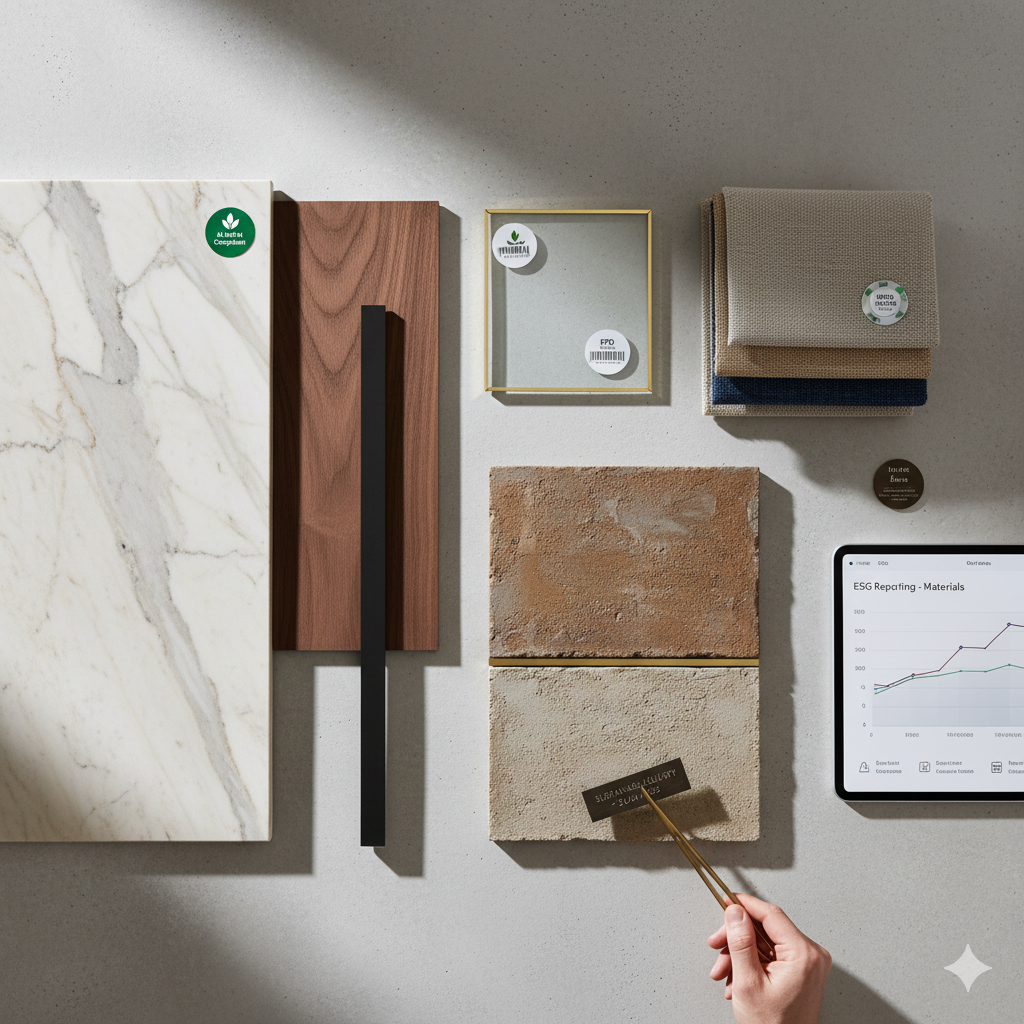
4) Delivery playbook: how you move from brief to handover
- Discovery. Vision workshops, adjacency mapping, code and Al Sa’fat targets, capex and opex.
- Concept. Mood and narrative, zoning, RCP concept, early DCD strategy, base MEP constraints.
- Schematic. Plans, sections, elevations, preliminary lighting and acoustics, outline specs, cost plan.
- Design Development. Joinery details, material schedules, performance specs, coordinated MEP, AV, IT, security.
- Authority submissions. DM and DCD packages, free-zone fit-out permit set, responses and revisions. dda.gov.ae
- Tender and procurement. Prequalification, BOQs, alternates, mock-ups, samples, and value engineering aligned to Al Sa’fat. Dubai Municipality
- Construction and commissioning. Shop drawings, inspections, testing, snagging, O&M manuals, and soft-landing.
5) Performance targets that make interiors feel right
- Thermal comfort. Occupied setpoint 22–24 °C with stable RH around 40–60% in mixed-mode areas.
- Lighting. 300–500 lux on horizontal work planes in offices and back-of-house. 150–300 lux in hotel guestroom ambient layers. Focused 700–1,000 lux for task nodes.
- Acoustics. Aim for STC 50+ to bedrooms and STC 45+ to internal partitions in premium residential. NRC 0.7+ for ceiling systems in collaboration zones. Background noise NC 30–35 in offices.
- Air quality. Low-VOC paints, adhesives, and sealants per Al Sa’fat tables. Size filtration and fresh air for occupancy and use. Dubai Municipality
- Fire and life safety. Coordinate with DCD early and keep finish classifications compliant under the national code. Dubai Civil Defense
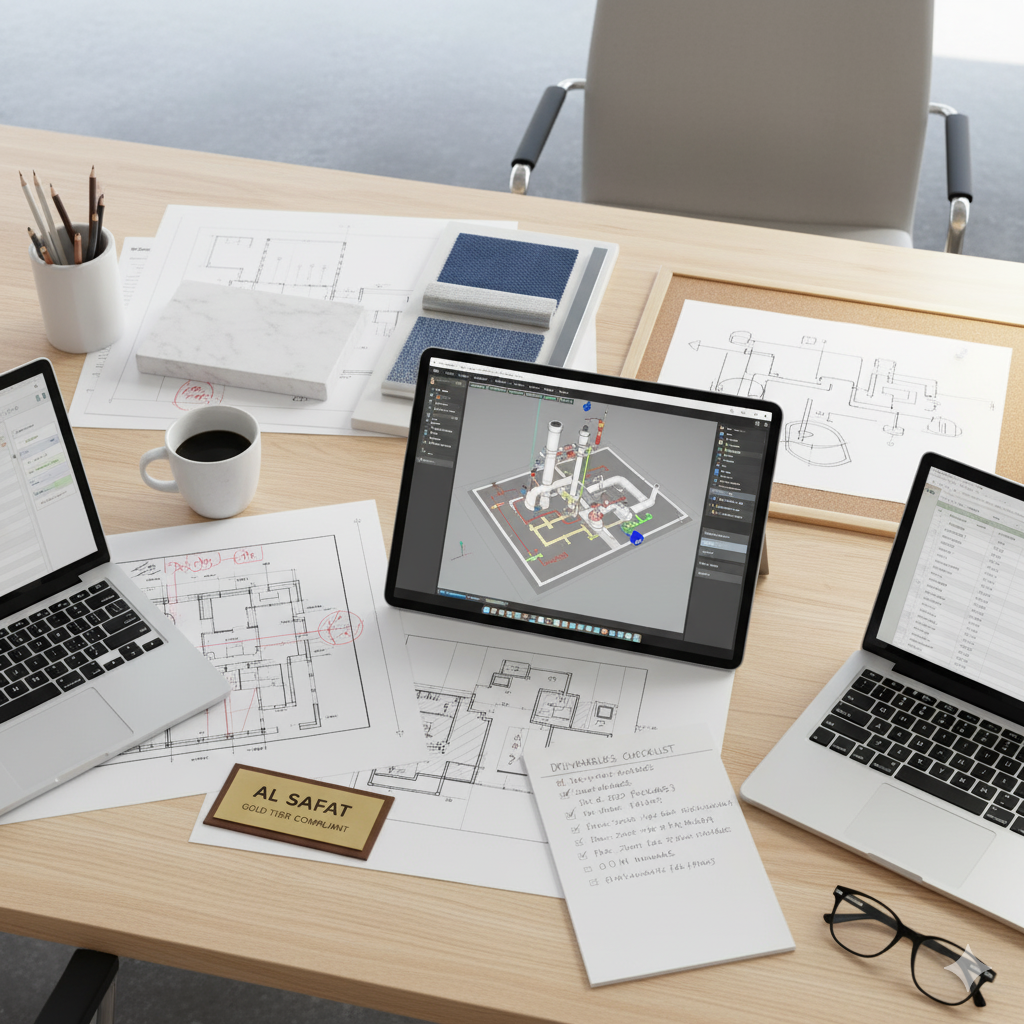
6) Materials and craft that win in Dubai
- Stone and solid surfaces. Specify slip resistance in wet zones and sealers that handle desalinated water.
- Timber and veneers. Use engineered cores for stability. Moisture-resistant carcasses in kitchens and back-of-house.
- Metals and glass. Powder-coated aluminum for doors and trims. Stainless in coastal exposures. Low-iron glass for showcases.
- Walls and floors. Micro-cement and high-build artisanal plasters work well with the right substrates and movement joints.
- Sustainability. Track low-emission criteria and recycled content against Al Sa’fat. Capture EPDs for major lines to support ESG reporting. Dubai Municipality
7) MEP and technology you should integrate from day one
- Smart controls. Automation for lighting, HVAC, and shading now ships as standard in Grade-A offices and upper-tier residential.
- BIM and coordination. Run clash detection before authority submissions. Deliver IFC and asset data for digital-twin-ready FM.
- Wellness. Daylight access, glare control, biophilic layers, and clean-air strategies appear in RFPs across sectors. Many owners align with LEED and the WELL Building Standard to document performance. US Green Building Council+1
8) Approvals, submittals, and life safety essentials
- DCD governs life safety. Align finish classes, means of egress, fire alarm, and suppression to the UAE Fire and Life Safety Code. Schedule inspections and keep witness points on the program. Dubai Civil Defense
- Free-zone fit-outs. Use the DDA portal for the Fit-Out Permit and completion sign-off. Upload GA plans, RCPs, MEP, materials, and method statements. dda.gov.ae
9) Costs, lead times, and procurement in 2025
- Office fit-out benchmarks. Use recognized market guides to sanity-check budgets for Dubai across low, medium, and high specifications. Turner & Townsend’s 2025 report remains a reliable baseline when you size capex and compare tiers. Turner & Townsend
- Typical lead times. Custom joinery 6–10 weeks. Imported lighting 8–14 weeks. Stone 8–12 weeks. Bespoke furniture 10–16 weeks. Lock mock-ups early to protect the schedule.
- Contracting routes. Design-bid-build gives you price tension with a longer pre-construction phase. Design-and-build compresses program and lifts coordination when scope is tight and risk appetite is low.
10) Sector-specific notes you can act on
- Luxury residential and branded living. Hidden tech, acoustic privacy, and hotel-grade amenity lounges move units.
- Hospitality and F&B. Back-of-house flow, BOH finishes, and kitchen MEP drive operational success as much as front-of-house story.
- Workplace. Fewer fixed desks, more collaboration and focus rooms, with circadian lighting and acoustic control for measurable productivity.
- Healthcare and education. Clear wayfinding, antimicrobial touchpoints, and resilient finishes reduce maintenance cycles.
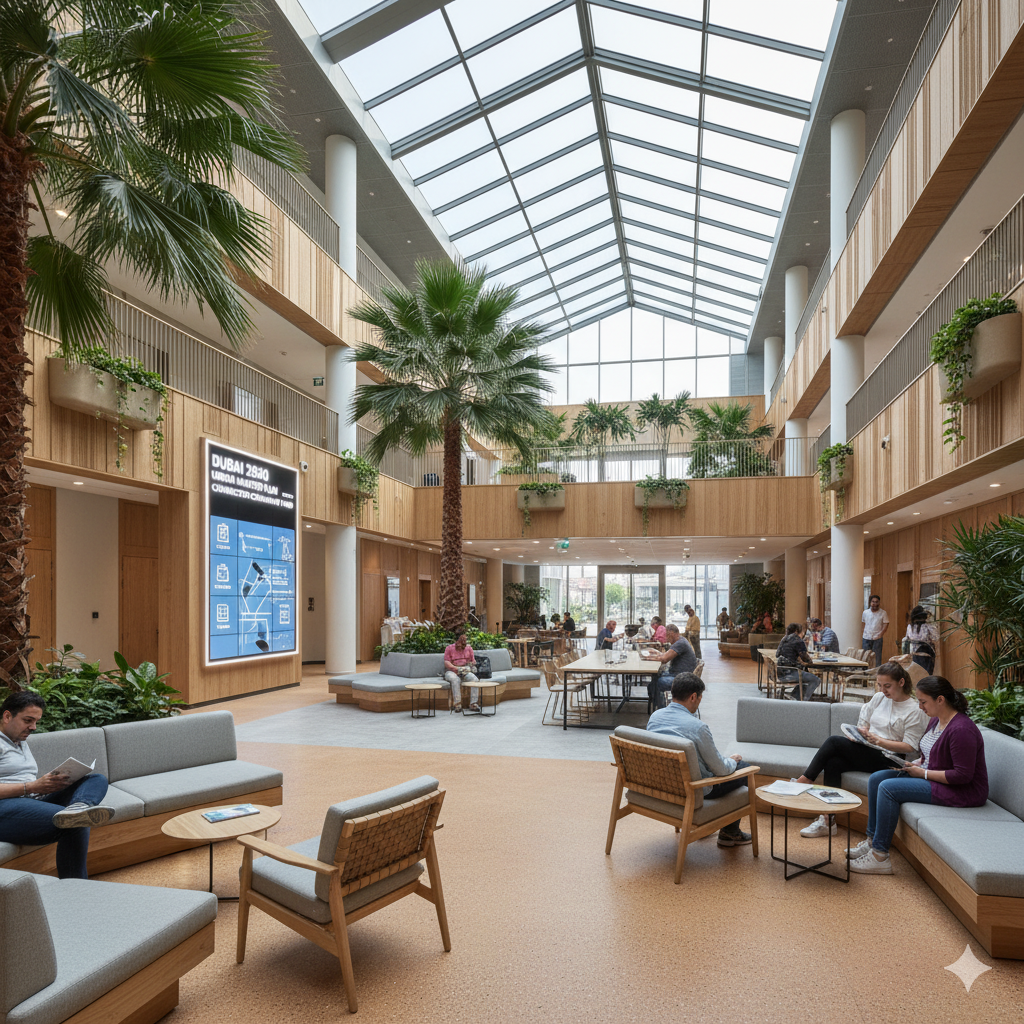
11) Your deliverables checklist
Design — brief, concept deck, layouts, sections, RCPs, elevations, joinery and detail packs, visuals.
Engineering — coordinated MEP, AV, IT, security.
Specifications — finishes, sanitary, lighting, hardware, appliances, performance criteria.
Commercial — BOQs, schedules, alternates, value engineering log.
Authority — DM and DCD packages, free-zone permit set, responses.
Handover — O&M manuals, warranties, cleaning and care guides, asset register.
12) Risks you can remove early
Authority rework. Start DCD coordination during concept. Map travel distances, fire zones, and exit widths on day one. Dubai Civil Defense
Supply variance. Approve full mock-ups and control samples. Require batch control for stone and veneer.
Thermal and glare issues. Simulate solar gain and daylight. Align shading controls with façade geometry.
Program drift. Fix decision gates at concept freeze, DD freeze, and IFC. Tie procurement to those dates.
13) The next five years in Dubai interiors (2026–2030)
Growth with quality. Expect steady growth as spend concentrates on higher performance, longer-life interiors.
Sustainability as default. Al Sa’fat compliance deepens. Owners increasingly document wellness and environmental performance through LEED and WELL. Dubai Municipality+2US Green Building Council+2
Community focus. The Dubai 2040 Urban Master Plan keeps briefs anchored to 20-minute neighborhoods and human-scaled public interiors.